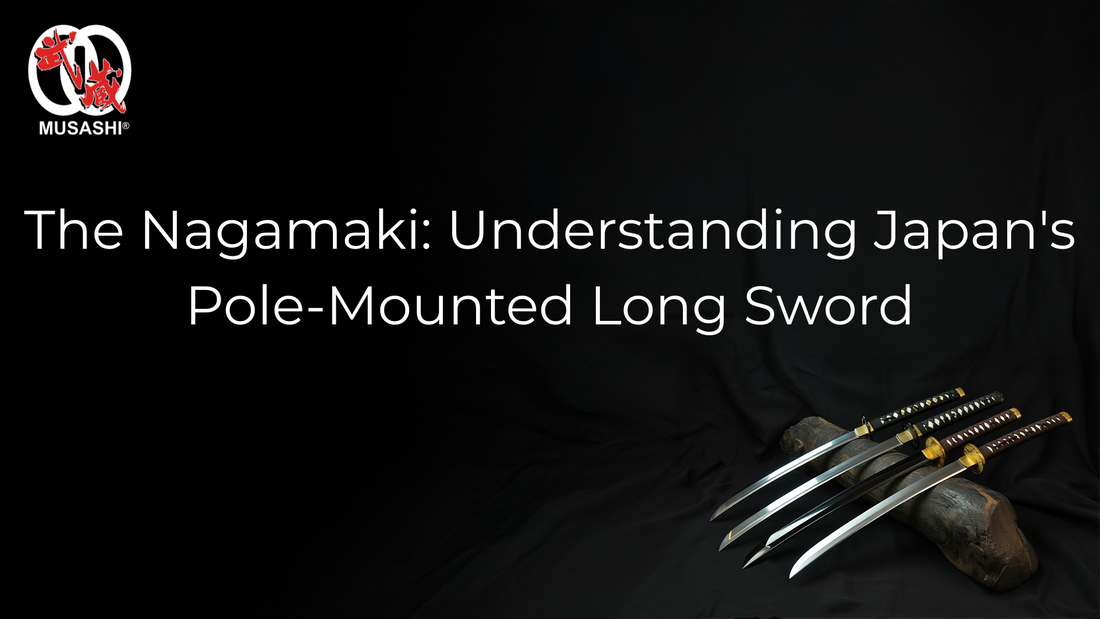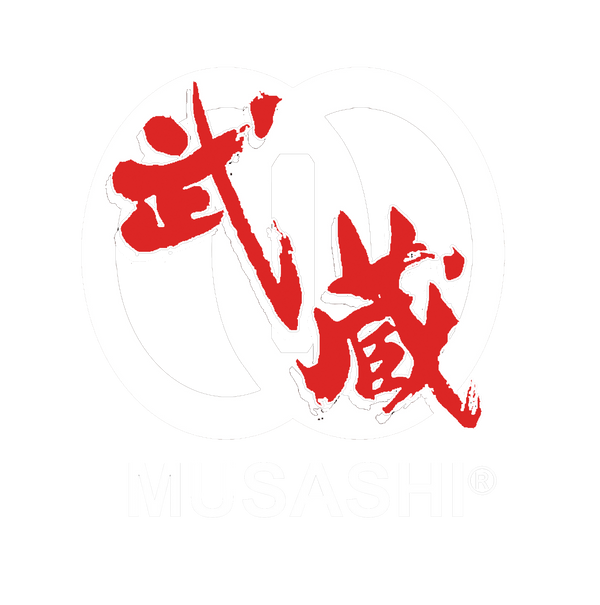
The Nagamaki Sword Explained - A Guide by Musashi Swords
The Nagamaki - Understanding Japan's Pole-Mounted Long Sword is essential to grasp the unique design and historical significance of the nagamaki sword, a weapon favoured by samurai in feudal Japan. Musashi Swords highlights how the modern warrior nagamaki remains a symbol of strength and skill in traditional Japanese martial arts.
The Nagamaki's Emergence in Feudal Japan
The nagamaki is a unique Japanese pole-mounted long sword. It first showed up during the feudal times of Japan. This ancient Japanese weapon played a big role in samurai culture. It was more than just a tool—it stood for warrior sword heritage. The blade is long and fixed to a wooden shaft. That made it useful on the battlefield, blending reach with strong strikes. Samurai used it as both a weapon and a symbol of their history.
Early Appearances and Initial Uses
At first, the nagamaki was joined by many types of Japanese war equipment. It fit well into hand-to-hand combat scenes. This sword helped warriors keep their distance while fighting several enemies at once. Using it was part of martial tradition. The weapon worked with other Asian polearms to give fighters an edge during battles.
Evolution of Design and Construction Over Time
The nagamaki changed a lot over the years. Craftsmen used traditional forging methods to make strong blades. Each one was handcrafted carefully by skilled smiths. These hand-forged nagamaki blades showed true swordmaking skill. They followed old techniques that passed from master to apprentice for centuries.
Notable Samurai Who Wielded the Nagamaki
Some famous samurai carried this sword proudly. Notably, the Miyamoto Musashi collection celebrates legendary warriors who, like Musashi himself, mastered weapons such as the nagamaki. Uesugi Kenshu from Echigo province relied on it during the Sengoku period fights.This weapon served bushi warriors, mounted warriors, and Ashigaru foot soldiers under Daimyo Oda Nobunaga, too.
Decline and Replacement by Other Weapons
The rise of firearms changed how battles were fought. Shifting battlefield tactics made close combat less common. So weapons like swords began to lose ground against guns and other arms. Polearm leverage mattered less when shooters ruled the field instead of swordsmen or polearm users. Understanding these points shows how much this ancient weapon links to samurai heritage today—and why Musashi Swords keeps its tradition alive with their handmade blades.
Usage of the Nagamaki in Warfare
The nagamaki is a special Japanese pole-mounted long sword. It looks like a mix between a sword and a polearm.Samurai swords and ashigaru foot soldiers used it a lot during feudal Japan.This weapon worked well on battlefields because it had reach and power.
In historical warfare in Japan, the nagamaki held an important place among other samurai swords and polearms. It worked well in group formations where each soldier's weapon mattered a lot. This made the nagamaki a key tool for many fighters back then.
Comparison to Similar Japanese Weapons
The nagamaki is a special kind of Japanese pole-mounted long sword. It mixes parts of traditional samurai swords with the length and reach of polearms. The naginata has a thin, curved blade for wide sweeping strikes. But the nagamaki's blade is wider and looks more like a katana's curved blade.This gives it stronger cutting power but still works well in close fights.
Traditional Japanese swords like the katana focus on speed and precision. The nagamaki combines these with extra reach from its long handle. This makes it flexible and tough on Japan's battlefields, where fighters had to adapt fast.
Relationship to the Naginata and Nodachi
The nagamaki, naginata, and nodachi all belong to Asian polearms used by samurai warriors. But each had its own role in battle. The naginata has a thin blade on a wooden shaft made for wide swings against soldiers or horses.It works well for mounted combat but needs room to move.The nodachi sword was mainly an anti-cavalry weapon because it was very long, but it took great strength and skill to use. The nagamaki sits between these two. It balances reach with control well. Its design lets warriors handle it precisely like regular swords, but still hit hard like other polearms during horse or foot battles.
The Nagamaki's Cultural Significance
- The Nagamaki has a special place in samurai tradition, reflecting the deep bushido spirit and heritage found in our traditional Japanese swords collection that honors the legacy of these time-honored weapons. This long sword with a pole-like handle stands for an honourable tradition passed down over time.
- Its long handle helped warriors fight with power and control. The sword is a symbol of cultural heritage. It shows martial skill and the legacy of discipline and respect that the samurai lived by. Its shape and use follow old customs that value loyalty, courage, and mastery—key parts of the samurai spirit.
-
Here's what the Nagamaki represents:
- Samurai tradition and values
- Bushido's code of honour
- A link to the samurai heritage
- An honourable tradition from the past
- The legacy of discipline and respect
- The spirit of loyalty and courage
Symbolic Representation of Samurai Tradition
- The Nagamaki is more than just a weapon. It carries strong symbolic meaning tied to bushido—the code the samurai lived by. The sword shows legendary valour and clear honour.
- Each part of it shows careful craftsmanship that matches a warrior's duty to improve and serve. The blade stands for respect, passion for skill, and sticking to tradition.So, it is not just a tool but a smart tribute to samurai values kept alive through history.
- The sword reflects:
- Bushido and samurai values
- Respect toward others
- Passion for doing things well
- Legendary honor
- Refined craftsmanship
- Knowledge passed through generations
Nagamaki in Japanese Art, Literature, and Media
- The Nagamaki appears often in Japanese art and stories. It stands for strength or noble traits in character. Old records tell about its use in battles during feudal times.
- Paintings show warriors holding this strong but graceful sword. In fiction—from old dramas to modern manga—it shines as a symbol of pride or courage. These stories keep their meaning alive by mixing history with creative tales that show Japan's love for swords as cultural icons.
Modern Appreciation and Reproductions
- Today, many people still care about the Nagamaki. Sword fans like those who make it using old forging ways and care about fine craftsmanship and dedication.
- New versions try hard to keep their legacy by using good steel made with old methods from skilled smiths. Collectors prize these swords because they link to real history—a way to touch past honour-bound traditions now loved by communities who want to keep Japan's martial arts culture alive.
Features Designed for Practical Use and Display
- This nagamaki works well both in battle practice and as art. The grip feels good, letting users control moves precisely during training or shows. It's battle-ready but also looks amazing when shown off.You can place it in nice sword display cases that bring out its sharp design and fine work.
- Practical Use: Handle fits hands well; blade stays sharp for cutting
- Display Appeal: Artistic style shows tradition; smooth finish catches eyes
- So, the nagamaki is a strong weapon and a beautiful piece to show.
Unique Characteristics of the Nagamaki
- A heavy blade combined with a long handle allows powerful leverage.
- Blade features include a yokote ridge and kissaki point for sharp cutting edges.
- Tang of the blade (nakago) ensures solid construction with a full tang design.
Cultural Legacy & Modern Enthusiasm
- Revered among sword enthusiasts for its superior craftsmanship and dedication.
- Popular in Japanese martial arts as a battle-ready yet artistic piece.
- Appreciated by collectors valuing traditional steel types like 1065 carbon steel.
- Symbolises noble heritage and the samurai spirit passed through generations.


